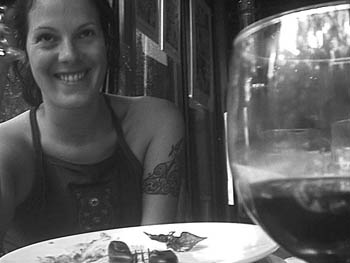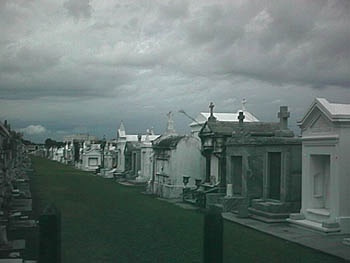|
|
|
New Orleans Oktoberfest
Friday, October 8 1999
Eventually Kim and I made it out of "our apartment" and down to Café Degas on Esplanade and sat down to dine in what must usually be a breezy patio area. But since it was a humid, rainy day, the patio was mostly sealed up behind stout transparent plastic drapes. All the waiters were older white men, and ours seemed especially well-connected with the local art scene, shall we say. He must have been doing his job particularly well today because somehow he convinced me to say what the hell and order the $30 bottle of a California Merlot (as opposed to the $18 bottle).
The waiter recommended that we continue on to the New Orleans Museum of Art and check out the "Dufy: Last of the Fauves" exhibit.
The museum wasn't far away, so Kim and I headed towards it on foot. Along the way we stopped to take pictures in a graveyard, a common subject of amateur photography in New Orleans. Like everything else in the city, there's something a bit odd about the way the dead are buried. They can't simply be chucked in the clay; they'd eventually come bubbling back up with the ground water after such simple disposal. Instead they're placed in small stone houses like the rich people in other places. Graveyards in New Orleans consist entirely of such buildings. Those who cannot afford their own stone houses are entombed in concrete communal mausoleums. In a very real sense the graveyards are "cities of the dead."
There's nothing special about the New Orleans Museum of Art and there's also nothing special about the art of Raoul Dufy. This is not to say that he didn't paint some good paintings. But most of the works hanging in this particular exhibit were mediocre at best. Many of them looked to be in an unfinished state. And it didn't look like Dufy had simply been distracted away from his masterpieces; I'm talking here about the kind of unfinished that results from artistic apathy, an apathy with roots in such things as poor initial composition. I was especially underwhelmed by the "Black Ships Series" Dufy did near the end of his life.
I was far more impressed with the exhibit of a local artist named John Clemmer up on the second floor. Clemmer's paintings were consistently strong, ranging from total abstraction to a sort of cubism-derived naturalism. The only weak part of his show was a collection of works from his "pastel period."
Oktoberfest with the all-white German people in their wood-paneled Valhalla.
Lindsay and Jay had been talking for days about what a great tradition known as New Orleans Oktoberfest. A few years back they'd found Oktoberfest happening at a big rambling compound called Deutsche Haus. It's a place run by a New Orleans German-heritage-celebrating social organization. Tonight we decided to catch a ride to Oktoberfest with Jay. It sounded like a David Lynchian blast.
But who could have predicted how much of a cultural experience we were in for? The place was completely packed with people. Once we'd paid our $3 admission, we could see the people. They were a certain kind of person I rarely see distilled in such numbers. All of them were white, most of them were middle aged, and nearly all of them were strictly middle-class, middle-American, right down to their 20 years out-of-fashion JC Penny-purchased clothing. The nearest I've ever seen to such a congregation was through the windows of a Veterans of Foreign Wars headquarters.
While Jay waited in the extremely long food line for unspectacular cuisine such as sauerkraut and sausage, Kim and I hung out with Lindsay and some dark German beer, looking around at the scene.
There was an Oompa band of older guys in Lederhosen milling about. The singer was especially old and fat, but with his skinny bare legs he looked a little like an apple on a stick.
Without a gentle, Lynchian appreciation for the thoroughly genuine (if matter-of-factly banal) in American culture, this experience would have been hard to take. One teenage girl with an evident interest in current fashion looked as if she was drowning, surrounded as she was by her oh-so conventional mother, kid brothers, and greasy flavourless food. She kept looking over at Kim as if to assure herself that perhaps this event wasn't the dork level of Dante's inferno.
Jay came back with his plate of greasy German food, telling of an "air conditioned wonderland" upstairs. So we followed after him.
One interesting thing about private social organizations is that they're not governed by the same rules that governs public organizations. A private organization can build its buildings any way it sees fit, without much regard for safety, fires, or the handicapped. In this particular case, Deutsche Haus had the cramped feel of a hastily-erected addition to a mobile home even though it contained vast halls that could seat many dozens of people. As we followed Jay up the stairs, other people coming downward had to squeeze past past us against the dingy wooden paneled walls. Everything was clean, tidy and seemingly well-built, but it didn't even have the grandness of an elementary school class room.
We hung out for a time with some of Lindsay and Jay's friends, including a guy named Barbecue Dave and a Jewish-looking woman who said of her two teenage sons, "One of them has acne and the other one doesn't."
After I'd had a few beers, Kim and I gradually started fighting more and more, especially when it seemed I wanted to wander the courtyard of Deutsche Haus without her. [REDACTED]
There was only one black man at Oktoberfest, and he appeared to be a hired hand sent to make sure things stayed clean. I went out of my way to be nice to him, not wanting to come across as yet another white guy there to take advantage of the fact that Oktoberfest is a more socially acceptable form of white fraternization than cross burnings.
Next on the agenda was an art opening. I was so drunk by this point that I remember almost none of what happened. Kim tells me the art consisted of illuminated boxes and that I wasn't impressed by them.

Kim at Café Degas drinking expensive wine.

The spooky graveyard.

Somehow Kim gets my camera to work in the graveyard. Yes, that's a Calvin Klein tee shirt.

More from a city of the dead.
For linking purposes this article's URL is:
http://asecular.com/blog.php?991008 feedback
previous | next |



